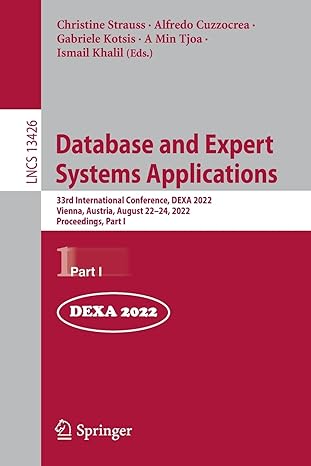Answered step by step
Verified Expert Solution
Question
1 Approved Answer
R2 20.20.20.0 /28 Fa0/0 Fa0/1 Subnet #1 Fa0/0 Subnet #2 Fa0/0 PC1 Internet R1 ISP Loopback 209.101.21.1/32 Inside network Outside network PC 2 For inside
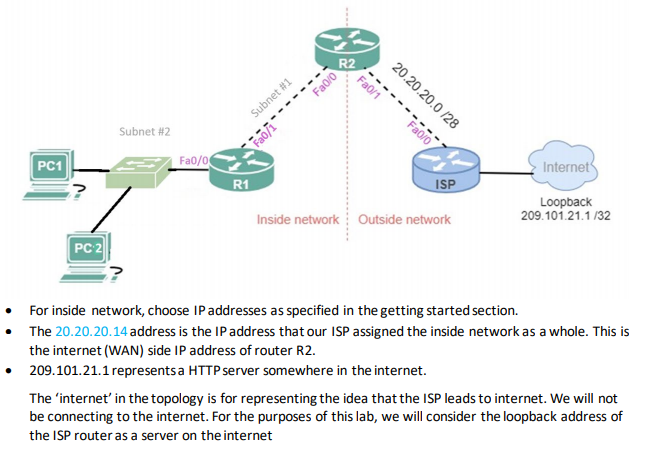
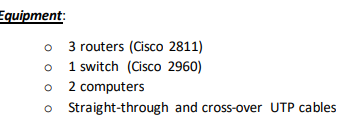
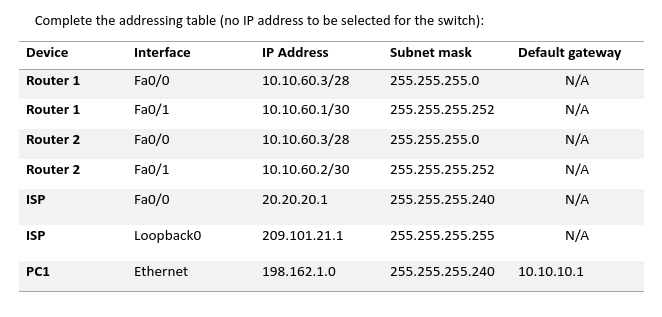
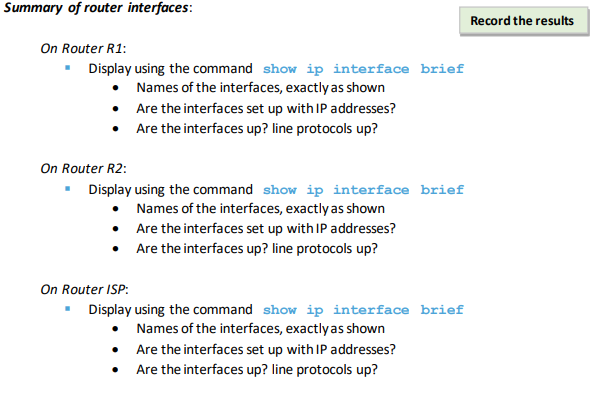
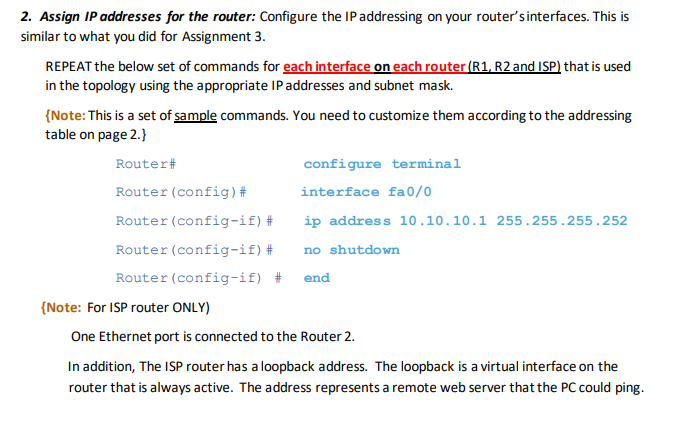

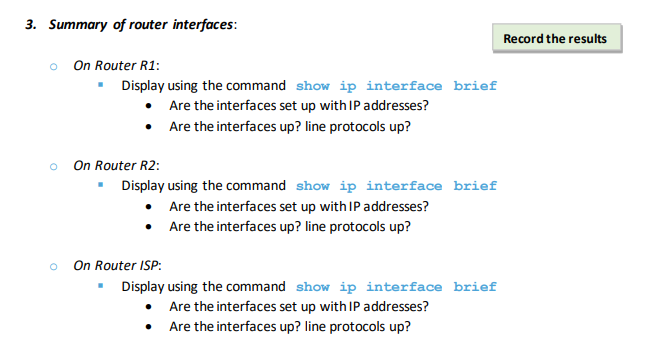
R2 20.20.20.0 /28 Fa0/0 Fa0/1 Subnet #1 Fa0/0 Subnet #2 Fa0/0 PC1 Internet R1 ISP Loopback 209.101.21.1/32 Inside network Outside network PC 2 For inside network, choose IP addresses as specified in the getting started section. The 20.20.20.14 address is the IP address that our ISP assigned the inside network as a whole. This is the internet (WAN) side IP address of router R2. 209.101.21.1 represents a HTTP server somewhere in the internet. The 'internet' in the topology is for representing the idea that the ISP leads to internet. We will not be connecting to the internet. For the purposes of this lab, we will consider the loopback address of the ISP router as a server on the internet Equipment: o 3 routers (Cisco 2811) o 1 switch (Cisco 2960) o 2 computers o Straight-through and cross-over UTP cables Complete the addressing table (no IP address to be selected for the switch): Device Router 1 Router 1 Subnet mask 255.255.255.0 Default gateway N/A Interface Fa0/0 Fa0/1 Fa0/0 IP Address 10.10.60.3/28 10.10.60.1/30 10.10.60.3/28 10.10.60.2/30 255.255.255.252 N/A Router 2 255.255.255.0 N/A Router 2 Fa0/1 255.255.255.252 N/A ISP Fa0/0 20.20.20.1 255.255.255.240 N/A ISP Loopbacko 209.101.21.1 255.255.255.255 N/A PC1 Ethernet 198.162.1.0 255.255.255.240 10.10.10.1 Summary of router interfaces: Record the results On Router R1: Display using the command show ip interface brief Names of the interfaces, exactly as shown Are the interfaces set up with IP addresses? Are the interfaces up? line protocols up? On Router R2: Display using the command show ip interface brief Names of the interfaces, exactly as shown Are the interfaces set up with IP addresses? Are the interfaces up? line protocols up? On Router ISP: Display using the command show ip interface brief Names of the interfaces, exactly as shown Are the interfaces set up with IP addresses? Are the interfaces up? line protocols up? 2. Assign IP addresses for the router: Configure the IP addressing on your router's interfaces. This is similar to what you did for Assignment 3. REPEAT the below set of commands for each interface on each router (R1, R2 and ISP) that is used in the topology using the appropriate IP addresses and subnet mask. {Note: This is a set of sample commands. You need to customize them according to the addressing table on page 2.) Router# configure terminal Router (config)# interface fa0/0 Router (config-if)# ip address 10.10.10.1 255.255.255.252 Router (config-if)# no shutdown Router (config-if)# end {Note: For ISP router ONLY) One Ethernet port is connected to the Router 2. In addition, The ISP router has a loopback address. The loopback is a virtual interface on the router that is always active. The address represents a remote web server that the PC could ping. You can configure the IP address on the loopbacko interface as follows (exact commands shown): ISP (config)# interface loopbacko ISP (config-if)# ip address 209.101.21.1 255.255.255.255 ISP (config-if)# no shutdown ISP (config-if)# end 3. Summary of router interfaces: Record the results On Router R1: Display using the command show ip interface brief Are the interfaces set up with IP addresses? Are the interfaces up? line protocols up? On Router R2: Display using the command show ip interface brief Are the interfaces set up with IP addresses? Are the interfaces up? line protocols up? o On Router ISP: Display using the command show ip interface brief Are the interfaces set up with IP addresses? Are the interfaces up? line protocols up? R2 20.20.20.0 /28 Fa0/0 Fa0/1 Subnet #1 Fa0/0 Subnet #2 Fa0/0 PC1 Internet R1 ISP Loopback 209.101.21.1/32 Inside network Outside network PC 2 For inside network, choose IP addresses as specified in the getting started section. The 20.20.20.14 address is the IP address that our ISP assigned the inside network as a whole. This is the internet (WAN) side IP address of router R2. 209.101.21.1 represents a HTTP server somewhere in the internet. The 'internet' in the topology is for representing the idea that the ISP leads to internet. We will not be connecting to the internet. For the purposes of this lab, we will consider the loopback address of the ISP router as a server on the internet Equipment: o 3 routers (Cisco 2811) o 1 switch (Cisco 2960) o 2 computers o Straight-through and cross-over UTP cables Complete the addressing table (no IP address to be selected for the switch): Device Router 1 Router 1 Subnet mask 255.255.255.0 Default gateway N/A Interface Fa0/0 Fa0/1 Fa0/0 IP Address 10.10.60.3/28 10.10.60.1/30 10.10.60.3/28 10.10.60.2/30 255.255.255.252 N/A Router 2 255.255.255.0 N/A Router 2 Fa0/1 255.255.255.252 N/A ISP Fa0/0 20.20.20.1 255.255.255.240 N/A ISP Loopbacko 209.101.21.1 255.255.255.255 N/A PC1 Ethernet 198.162.1.0 255.255.255.240 10.10.10.1 Summary of router interfaces: Record the results On Router R1: Display using the command show ip interface brief Names of the interfaces, exactly as shown Are the interfaces set up with IP addresses? Are the interfaces up? line protocols up? On Router R2: Display using the command show ip interface brief Names of the interfaces, exactly as shown Are the interfaces set up with IP addresses? Are the interfaces up? line protocols up? On Router ISP: Display using the command show ip interface brief Names of the interfaces, exactly as shown Are the interfaces set up with IP addresses? Are the interfaces up? line protocols up? 2. Assign IP addresses for the router: Configure the IP addressing on your router's interfaces. This is similar to what you did for Assignment 3. REPEAT the below set of commands for each interface on each router (R1, R2 and ISP) that is used in the topology using the appropriate IP addresses and subnet mask. {Note: This is a set of sample commands. You need to customize them according to the addressing table on page 2.) Router# configure terminal Router (config)# interface fa0/0 Router (config-if)# ip address 10.10.10.1 255.255.255.252 Router (config-if)# no shutdown Router (config-if)# end {Note: For ISP router ONLY) One Ethernet port is connected to the Router 2. In addition, The ISP router has a loopback address. The loopback is a virtual interface on the router that is always active. The address represents a remote web server that the PC could ping. You can configure the IP address on the loopbacko interface as follows (exact commands shown): ISP (config)# interface loopbacko ISP (config-if)# ip address 209.101.21.1 255.255.255.255 ISP (config-if)# no shutdown ISP (config-if)# end 3. Summary of router interfaces: Record the results On Router R1: Display using the command show ip interface brief Are the interfaces set up with IP addresses? Are the interfaces up? line protocols up? On Router R2: Display using the command show ip interface brief Are the interfaces set up with IP addresses? Are the interfaces up? line protocols up? o On Router ISP: Display using the command show ip interface brief Are the interfaces set up with IP addresses? Are the interfaces up? line protocols up
Step by Step Solution
There are 3 Steps involved in it
Step: 1

Get Instant Access to Expert-Tailored Solutions
See step-by-step solutions with expert insights and AI powered tools for academic success
Step: 2

Step: 3

Ace Your Homework with AI
Get the answers you need in no time with our AI-driven, step-by-step assistance
Get Started


